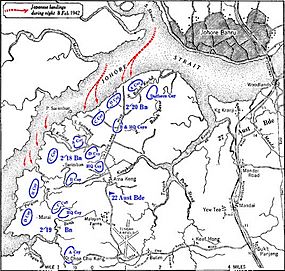Battle of Sarimbun Beach facts for kids
Quick facts for kids Battle of Sarimbun Beach |
|||||||
|---|---|---|---|---|---|---|---|
| Part of the Battle of Singapore, Pacific War | |||||||
 The positions of Allied forces in the Sarimbun area of Singapore at 10:00 p.m. (local time) on 8 February in 1942. The arrows indicate attacks by Japanese forces. |
|||||||
|
|||||||
| Belligerents | |||||||
| Commanders and leaders | |||||||
| Strength | |||||||
| ~3,000 | ~10,000 | ||||||
The Battle of Sarimbun Beach was the first major attack by Japanese forces on Singapore during World War II. This important battle happened in February 1942. Sarimbun Beach is located in the northwest part of Singapore.
Japanese troops, led by Lieutenant-General Tomoyuki Yamashita, first landed here. They attacked the Allied forces, mostly British and Australian soldiers. The main Allied commander in Singapore, Lieutenant-General Arthur Percival, did not expect the Japanese to attack from this area. Because of this, he did not send enough extra troops to help. The 22nd Australian Brigade faced the main Japanese attack. The Japanese goal after landing was to capture Tengah Airfield.
Contents
Preparing for Battle: Who Was There?
Before the battle, Lieutenant-General Percival put Major-General Gordon Bennett in charge of Singapore's northwest area. Bennett had two brigades from the 8th Australian Division. This area was mostly mangrove swamps and thick forests. Many rivers and creeks cut through the land.
Defending Sarimbun Beach
The 22nd Australian Infantry Brigade, led by Brigadier Harold Taylor, was given a large area to defend. This area was about 16 kilometers (10 miles) wide along Sarimbun Beach. They were joined by the Jind Infantry Battalion from Indian States Forces. This Indian unit was protecting Tengah Airfield. A company of Dalforce, a local militia group from Singaporean Chinese, also helped.
The 27th Australian Infantry Brigade defended an area next to them. This area was about 3,600 meters (4,000 yards) wide. It was close to the causeway connecting Singapore to Malaya. Machine gunners from the Australian 2/4th Australian Machine Gun Battalion were spread out among these infantry units.
The Battle Begins: A Night Attack
The fighting at Sarimbun Beach began late at night.
Japanese Landings and Fierce Fighting
At 10:30 p.m. on February 8, Australian machine gunners opened fire. They shot at boats carrying the first wave of Japanese troops. About 4,000 Japanese soldiers from the 5th and 18th Divisions were heading for Singapore Island. The Japanese quickly attacked Sarimbun Beach, where the 22nd Australian Brigade was waiting.
The battle was very intense throughout the night. The Japanese had many more soldiers. They also had better artillery, tanks, planes, and military information. These advantages slowly wore down the Allied defenders, who did not have enough support.
Allied Lines Break
The Japanese found weak spots in the Allied defense line along the coast. They used small rivers and creeks to get around the defenders. By midnight, the two Australian brigades defending the beach lost contact with each other. The 22nd Brigade had to retreat in a confused way. At 1:00 a.m., even more Japanese troops landed. The last Australian reserve soldiers were sent into the fight.
As dawn broke on February 9, parts of the 22nd Australian Brigade were surrounded or defeated. The 2/18th Australian Infantry Battalion in the middle lost more than half its soldiers. The 2/20th Australian Infantry Battalion on the right side was also fighting hard against the Japanese. The 2/19th Australian Infantry Battalion on the left was being outflanked. Only one company, "B" Company, was left to face the first Japanese landings.
General Percival did not send more troops to help the tired 22nd Australian Brigade. He waited until Tengah Airfield was almost captured. Before British and Indian soldiers arrived, the damaged Australian and Singaporean units, along with the Jinds, pulled back. They moved to the "Jurong Line" defense area. This line stretched south from the village of Bulim, east of the airfield. The Japanese took Tengah Airfield around midday on February 9.
After the Battle: A Small Victory
After dark on February 9, three British Fairmile B motor launches went on a mission. They went up the western channel of the Straits of Johor, near Sarimbun Beach. Their main goal was to attack Japanese landing boats and stop their communications.
The British boats came under fire from both sides of the strait. Japanese forces were shooting from Malaya to the north and Sarimbun Beach to the south. But the launches kept going almost all the way to the Causeway. They sank a few Japanese landing boats. The British launches then returned to Singapore with very little damage. Some Allied soldiers felt this showed how effective defensive tactics could be. They believed these tactics were used too little and too late by their senior commanders.
See also
- Malayan Campaign
- Japanese order of battle during the Malayan Campaign

